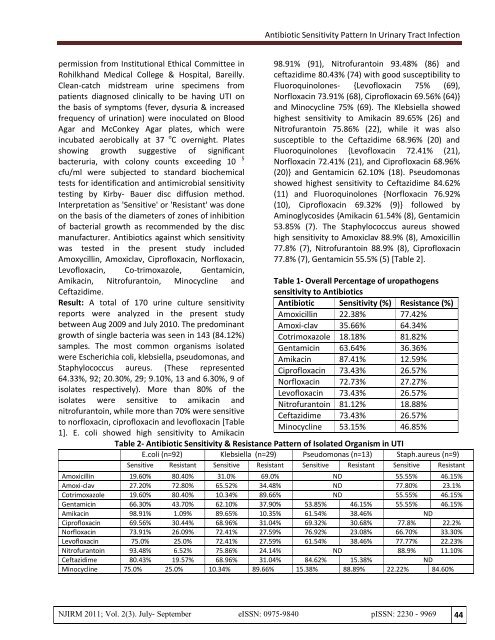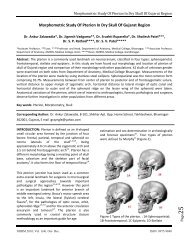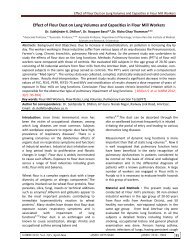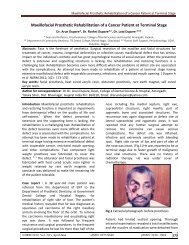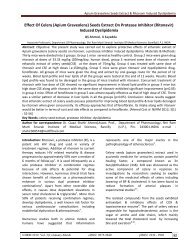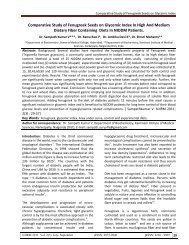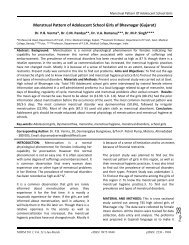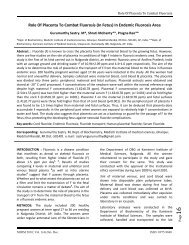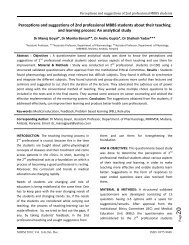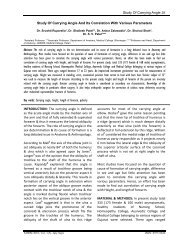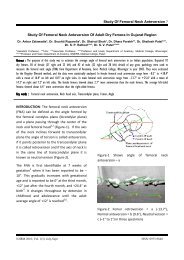Study of Antibiotic Sensitivity Pattern In Urinary Tract Infection At A ...
Study of Antibiotic Sensitivity Pattern In Urinary Tract Infection At A ...
Study of Antibiotic Sensitivity Pattern In Urinary Tract Infection At A ...
Create successful ePaper yourself
Turn your PDF publications into a flip-book with our unique Google optimized e-Paper software.
<strong>Antibiotic</strong> <strong>Sensitivity</strong> <strong>Pattern</strong> <strong>In</strong> <strong>Urinary</strong> <strong>Tract</strong> <strong>In</strong>fectionpermission from <strong>In</strong>stitutional Ethical Committee inRohilkhand Medical College & Hospital, Bareilly.Clean-catch midstream urine specimens frompatients diagnosed clinically to be having UTI onthe basis <strong>of</strong> symptoms (fever, dysuria & increasedfrequency <strong>of</strong> urination) were inoculated on BloodAgar and McConkey Agar plates, which wereincubated aerobically at 37 o C overnight. Platesshowing growth suggestive <strong>of</strong> significantbacteruria, with colony counts exceeding 10 5cfu/ml were subjected to standard biochemicaltests for identification and antimicrobial sensitivitytesting by Kirby- Bauer disc diffusion method.<strong>In</strong>terpretation as 'Sensitive' or 'Resistant' was doneon the basis <strong>of</strong> the diameters <strong>of</strong> zones <strong>of</strong> inhibition<strong>of</strong> bacterial growth as recommended by the discmanufacturer. <strong>Antibiotic</strong>s against which sensitivitywas tested in the present study includedAmoxycillin, Amoxiclav, Cipr<strong>of</strong>loxacin, Norfloxacin,Lev<strong>of</strong>loxacin, Co-trimoxazole, Gentamicin,Amikacin, Nitr<strong>of</strong>urantoin, Minocycline andCeftazidime.Result: A total <strong>of</strong> 170 urine culture sensitivityreports were analyzed in the present studybetween Aug 2009 and July 2010. The predominantgrowth <strong>of</strong> single bacteria was seen in 143 (84.12%)samples. The most common organisms isolatedwere Escherichia coli, klebsiella, pseudomonas, andStaphylococcus aureus. (These represented64.33%, 92; 20.30%, 29; 9.10%, 13 and 6.30%, 9 <strong>of</strong>isolates respectively). More than 80% <strong>of</strong> theisolates were sensitive to amikacin andnitr<strong>of</strong>urantoin, while more than 70% were sensitiveto norfloxacin, cipr<strong>of</strong>loxacin and lev<strong>of</strong>loxacin [Table1]. E. coli showed high sensitivity to Amikacin98.91% (91), Nitr<strong>of</strong>urantoin 93.48% (86) andceftazidime 80.43% (74) with good susceptibility toFluoroquinolones- {Lev<strong>of</strong>loxacin 75% (69),Norfloxacin 73.91% (68), Cipr<strong>of</strong>loxacin 69.56% (64)}and Minocycline 75% (69). The Klebsiella showedhighest sensitivity to Amikacin 89.65% (26) andNitr<strong>of</strong>urantoin 75.86% (22), while it was alsosusceptible to the Ceftazidime 68.96% (20) andFluoroquinolones {Lev<strong>of</strong>loxacin 72.41% (21),Norfloxacin 72.41% (21), and Cipr<strong>of</strong>loxacin 68.96%(20)} and Gentamicin 62.10% (18). Pseudomonasshowed highest sensitivity to Ceftazidime 84.62%(11) and Fluoroquinolones {Norfloxacin 76.92%(10), Cipr<strong>of</strong>loxacin 69.32% (9)} followed byAminoglycosides {Amikacin 61.54% (8), Gentamicin53.85% (7). The Staphylococcus aureus showedhigh sensitivity to Amoxiclav 88.9% (8), Amoxicillin77.8% (7), Nitr<strong>of</strong>urantoin 88.9% (8), Cipr<strong>of</strong>loxacin77.8% (7), Gentamicin 55.5% (5) [Table 2].Table 1- Overall Percentage <strong>of</strong> uropathogenssensitivity to <strong>Antibiotic</strong>s<strong>Antibiotic</strong> <strong>Sensitivity</strong> (%) Resistance (%)Amoxicillin 22.38% 77.42%Amoxi-clav 35.66% 64.34%Cotrimoxazole 18.18% 81.82%Gentamicin 63.64% 36.36%Amikacin 87.41% 12.59%Cipr<strong>of</strong>loxacin 73.43% 26.57%Norfloxacin 72.73% 27.27%Lev<strong>of</strong>loxacin 73.43% 26.57%Nitr<strong>of</strong>urantoin 81.12% 18.88%Ceftazidime 73.43% 26.57%Minocycline 53.15% 46.85%Table 2- <strong>Antibiotic</strong> <strong>Sensitivity</strong> & Resistance <strong>Pattern</strong> <strong>of</strong> Isolated Organism in UTIE.coli (n=92) Klebsiella (n=29) Pseudomonas (n=13) Staph.aureus (n=9)Sensitive Resistant Sensitive Resistant Sensitive Resistant Sensitive ResistantAmoxicillin 19.60% 80.40% 31.0% 69.0% ND 55.55% 46.15%Amoxi-clav 27.20% 72.80% 65.52% 34.48% ND 77.80% 23.1%Cotrimoxazole 19.60% 80.40% 10.34% 89.66% ND 55.55% 46.15%Gentamicin 66.30% 43.70% 62.10% 37.90% 53.85% 46.15% 55.55% 46.15%Amikacin 98.91% 1.09% 89.65% 10.35% 61.54% 38.46% NDCipr<strong>of</strong>loxacin 69.56% 30.44% 68.96% 31.04% 69.32% 30.68% 77.8% 22.2%Norfloxacin 73.91% 26.09% 72.41% 27.59% 76.92% 23.08% 66.70% 33.30%Lev<strong>of</strong>loxacin 75.0% 25.0% 72.41% 27.59% 61.54% 38.46% 77.77% 22.23%Nitr<strong>of</strong>urantoin 93.48% 6.52% 75.86% 24.14% ND 88.9% 11.10%Ceftazidime 80.43% 19.57% 68.96% 31.04% 84.62% 15.38% NDMinocycline 75.0% 25.0% 10.34% 89.66% 15.38% 88.89% 22.22% 84.60%NJIRM 2011; Vol. 2(3). July- September eISSN: 0975-9840 pISSN: 2230 - 9969 44


